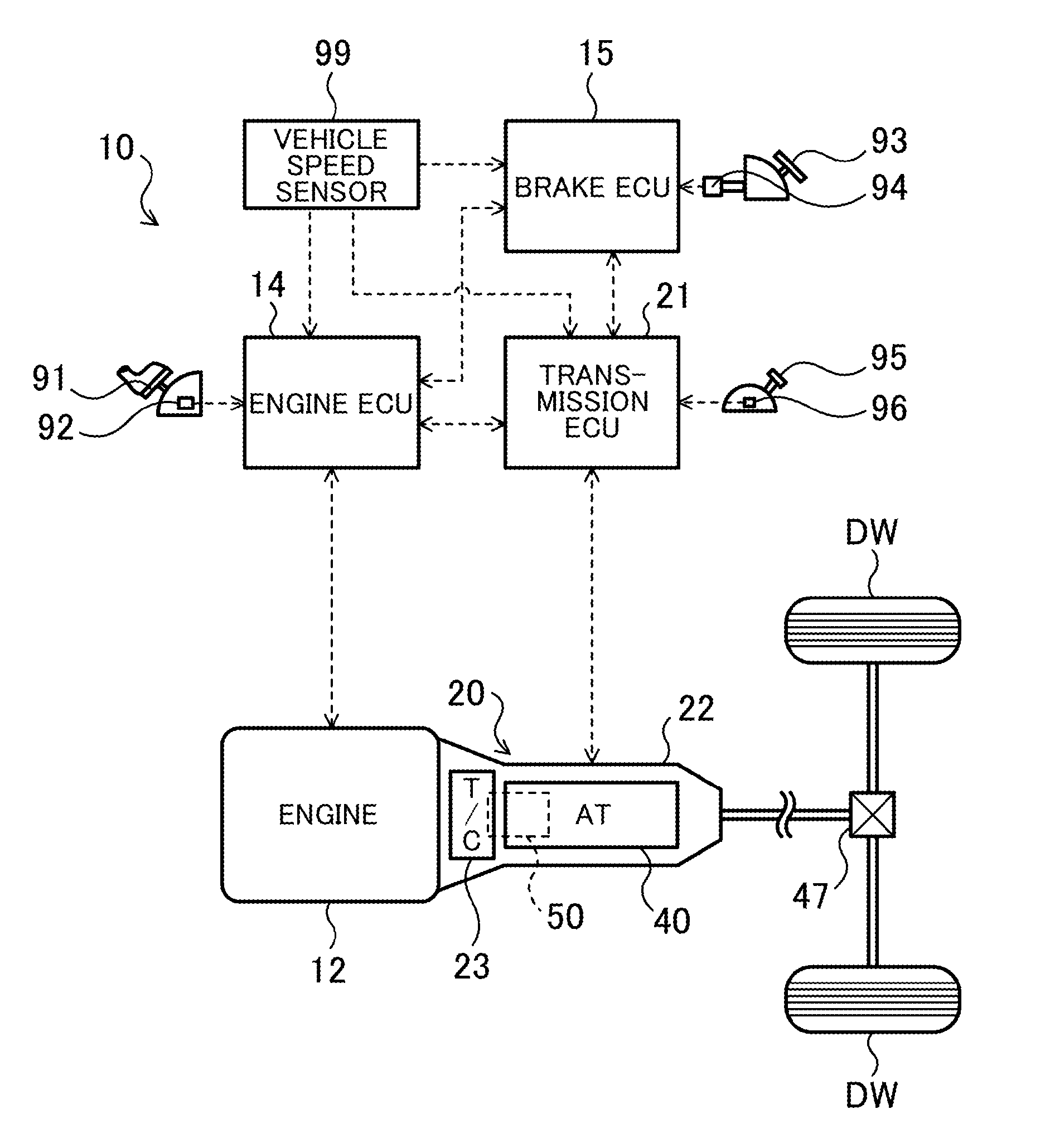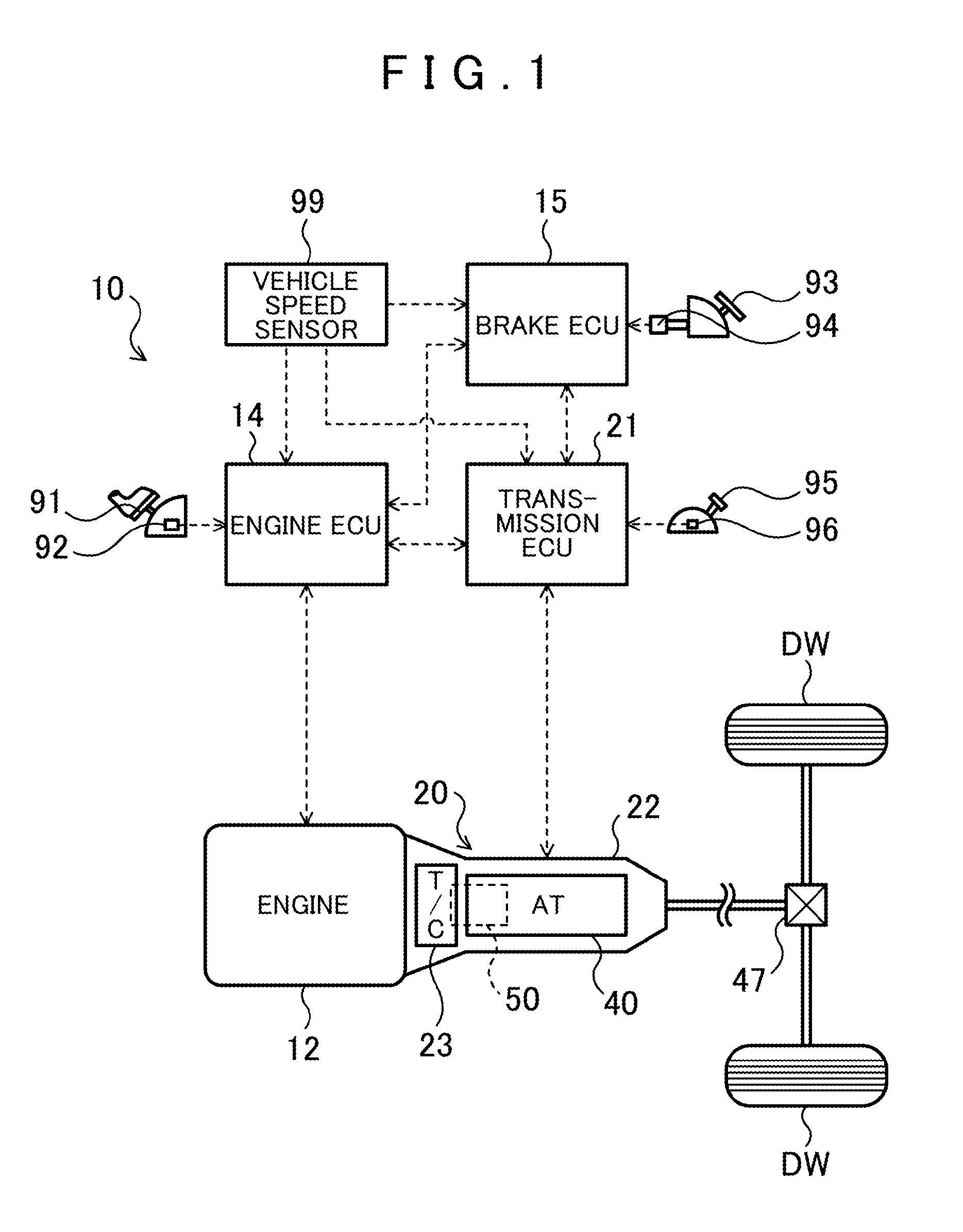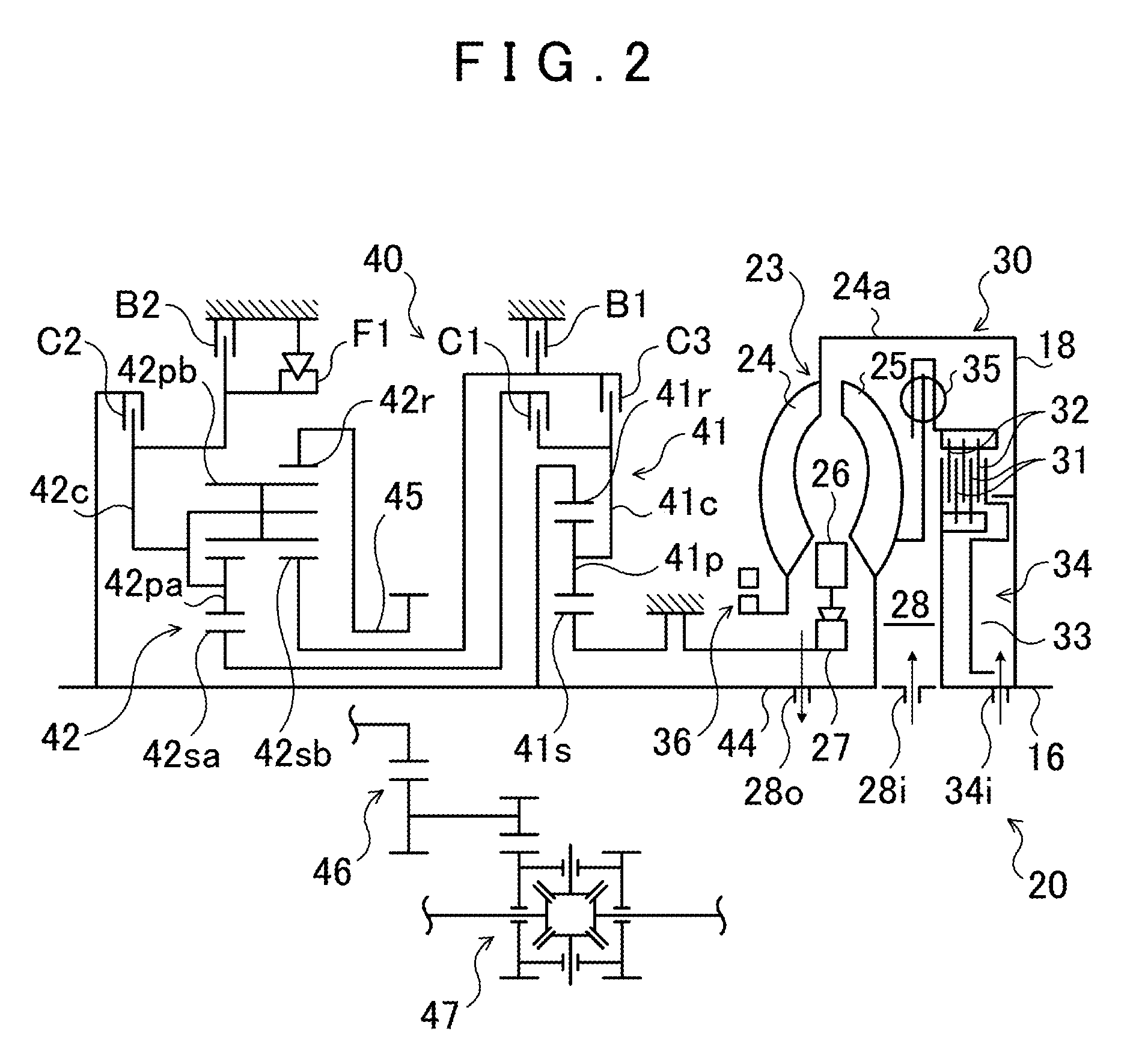[0006]Therefore, it is a primary objective of the present invention to provide a hydraulic pressure control device that more appropriately sets the hydraulic pressure in a hydraulic power transmission chamber in which power is transmitted by hydraulic power transmission elements via hydraulic oil, without using complicated control.
[0009]The circulating pressure setting valve of the hydraulic pressure control device according to the first aspect has the spool to which the circulating pressure is applied as a feedback pressure and another hydraulic pressure is applied in addition to the feedback pressure when the lock-up clutch is engaged or disengaged, and the spring that urges the spool, and sets the circulating pressure to the constant first pressure when the lock-up clutch is disengaged and to the constant second pressure different from the first pressure when the lock-up clutch is engaged, depending on the force given to the spool by the application of the feedback pressure and on the urging force given from the spring to the spool. According to the first aspect, the circulating pressure can be set to the constant first or second pressure in a stable manner when the lock-up clutch is either disengaged or engaged, and the necessity is eliminated to finely control the linear
solenoid valve, etc. according to the temperature of the hydraulic oil. In addition, by providing a different amount of the circulating pressure between when the lock-up clutch is disengaged and when it is engaged, the circulating pressure when the lock-up clutch is engaged can be a pressure in accordance with the mode of generation of the lock-up pressure by the lock-up pressure generating valve. Therefore, with the hydraulic pressure control device according to the first aspect, it is possible to more appropriately set the hydraulic pressure in the hydraulic power transmission chamber in which power is transmitted between the input-side hydraulic power transmission element and the output-side hydraulic power transmission element via hydraulic oil, without using complicated control.
[0010]According to a second aspect of the present invention, the lock-up pressure generating valve may generate the lock-up pressure so as to be higher than the circulating pressure when the lock-up clutch is engaged, and the other hydraulic pressure may be applied to the spool of the circulating pressure setting valve so that the spring is compressed more when the lock-up clutch is disengaged than when the lock-up clutch is engaged. According to the second aspect, when the lock-up clutch is disengaged, the circulating pressure is set to the first pressure that is higher, by an amount obtained by compression of the spring, than the second pressure that is set when the lock-up clutch is engaged. Therefore, when the lock-up clutch is disengaged,
cavitation can be suppressed from occurring in the hydraulic power transmission chamber by keeping the pressure in the hydraulic power transmission chamber at a high level to a certain extent. When the lock-up clutch is engaged, the circulating pressure is set to the second pressure that is lower than the first pressure. Therefore, when the lock-up clutch is engaged, both of the circulating pressure and the lock-up pressure supplied for engaging the lock-up clutch can be reduced, thereby reducing the source pressures of both pressures. Note that, if the lock-up pressure generating valve generates the lock-up pressure so as to be lower than the circulating pressure when the lock-up clutch is engaged, the other hydraulic pressure may be applied to the spool of the circulating pressure setting valve so that the spring is compressed more when the lock-up clutch is engaged than when the lock-up clutch is disengaged.
[0012]Moreover, according to a fourth aspect of the present invention, the spool of the circulating pressure setting valve may be arranged in a slidable manner in an axial direction in a valve hole formed in a valve body, and may have at least two lands provided at an
axial distance from each other; the spring of the circulating pressure setting valve may be arranged such that one end thereof comes in contact with the spool and another end thereof comes in contact with a
plunger arranged in a slidable manner in the axial direction in the valve hole; a pressure regulating chamber for regulating the circulating pressure may be defined by the valve body and the two lands of the spool, the pressure regulating chamber being communicable with an input port, an output port, and a drain port formed in the valve body; a first oil chamber to which the circulating pressure output from the output port is supplied as the feedback pressure may be defined so as to face the
plunger with the two lands of the spool interposed therebetween; and a second oil chamber to which the circulating pressure from the
relay valve is supplied may be defined so as to face the spring with the
plunger interposed therebetween. According to the fourth aspect, it is possible to set the circulating pressure to the first pressure when the lock-up clutch is disengaged, and to the second pressure when the lock-up clutch is engaged, without using complicated control while making the structure of the circulating pressure setting valve relatively simple. By improving arrangement of ports and oil passages of the valve body, shapes of separator plates, and the like, in addition to structuring the circulating pressure setting valve as described above, it is possible to easily structure a
regulator valve that generates a hydraulic pressure according to a
signal pressure from the linear
solenoid valve, by changing the spool and the spring arranged in the valve hole of the valve body.
[0013]Furthermore, according to a fifth aspect of the present invention, the hydraulic power transmission chamber may have a hydraulic oil inlet through which the circulating pressure is supplied from the
relay valve, and a hydraulic oil outlet for discharging the hydraulic oil; the
relay valve may have a discharged oil inflow port connected to the hydraulic oil outlet of the hydraulic power transmission chamber and three discharged oil outflow ports, and communicate the discharged oil inflow port with one of the three discharged oil outflow ports when the lock-up clutch is disengaged while communicating the discharged oil inflow port with two discharged oil outflow ports other than the one of the three discharged oil outflow ports when the lock-up clutch is engaged; and the lock-up pressure generating valve may have an inflow port connected to one of the two discharged oil outflow ports of the
relay valve, and an outflow port, and communicate the inflow port with the outflow port until the lock-up clutch is fully engaged and
cut off the communication between the inflow port and the outflow port when the lock-up clutch is fully engaged. According to the fifth aspect, when the lock-up clutch is fully engaged, unnecessary consumption of hydraulic
oil can be suppressed by reducing the amount of
discharge of the hydraulic oil from the hydraulic power transmission chamber, that is, the flow rate of the hydraulic oil circulating in the hydraulic power transmission chamber.
 Login to View More
Login to View More  Login to View More
Login to View More 


